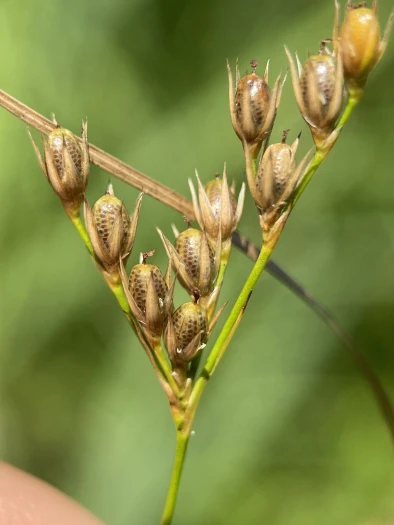Forked Rush
(Juncus dichotomus)
Forked Rush (Juncus dichotomus)
/
/

Zihao Wang
CC BY 4.0
Image By:
Zihao Wang
Recorded By:
Copyright:
CC BY 4.0
Copyright Notice:
Photo by: Zihao Wang | License Type: CC BY 4.0 | License URL: http://creativecommons.org/licenses/by/4.0/ | Rights Holder: Zihao Wang | Publisher: iNaturalist | Date Created: 2022-07-10T19:08:02Z |























Estimated Native Range
Climate Requirements for South Elgin, Illinois
| This Plant | Your Site | Plant Suitability for Your Location | ||
|---|---|---|---|---|
| • Precipitation | 10" - 182" | 37" | Aquatic | Aquatic |
| • High Temp. | 64°F - 102°F | 85°F | Your summer temperatures are normal for this plant. | Excellent |
| • Low Temp. | 6°F - 64°F | 12°F | Your winter temperatures are normal for this plant | Excellent |
This plant should grow well at your location with about N inches per year (Y minutes per month) of irrigation.
Summary
Juncus dichotomus, commonly known as Forked Rush, is a perennial herbaceous plant native to wetlands, marshes, and along the edges of ponds and streams in the Americas. It has been introduced to other temperate regions. Forked Rush typically grows to a height of 12-24 inches (30-60 cm) and is characterized by its grass-like appearance with flat or slightly rounded stems. The flowers are small, greenish or brownish, and clustered at the top of the stems, blooming in spring and summer. The flowers are not particularly showy, but the plant is easily identified by its unique forked inflorescence structure.
Forked Rush is valued for its ability to thrive in very moist areas, making it suitable for water gardens, riparian plantings, and as a soil stabilizer on riverbanks and in roadside ditches. It prefers full sun to part shade and requires consistently wet soil conditions. While it is not commonly used for ornamental purposes, its presence can be beneficial for erosion control and as habitat for wildlife. Gardeners should be aware that Juncus dichotomus can spread aggressively in suitable conditions and may become invasive, particularly in Europe where it is reported as such. Care should be taken to manage its growth and prevent unwanted spread.CC BY-SA 4.0
Forked Rush is valued for its ability to thrive in very moist areas, making it suitable for water gardens, riparian plantings, and as a soil stabilizer on riverbanks and in roadside ditches. It prefers full sun to part shade and requires consistently wet soil conditions. While it is not commonly used for ornamental purposes, its presence can be beneficial for erosion control and as habitat for wildlife. Gardeners should be aware that Juncus dichotomus can spread aggressively in suitable conditions and may become invasive, particularly in Europe where it is reported as such. Care should be taken to manage its growth and prevent unwanted spread.CC BY-SA 4.0
Plant Description
- Plant Type: Grass
- Height: 1-2.5 feet
- Width: 1-2 feet
- Growth Rate: Moderate
- Flower Color: N/A
- Flowering Season: Spring, Summer
- Leaf Retention: Deciduous
Growth Requirements
- Sun: Full Sun, Part Shade
- Water: Medium
- Drainage: Fast, Medium
Common Uses
Erosion Control, Low Maintenance, Water Garden
Natural Habitat
Wetlands, marshes, and along the edges of ponds and streams in the Americas
Other Names
Common Names: Jointleaf Rush
Scientific Names: Juncus dichotomus, Juncus albicans, Juncus cognatus, Juncus dichotomus var. dichotomus, Juncus dichotomus var. platyphyllus, Juncus platyphyllus, Juncus platyphyllus var. platyphyllus, Juncus tenuis subsp. dichotomus, Juncus tenuis var. dichotomus
GBIF Accepted Name: Juncus dichotomus